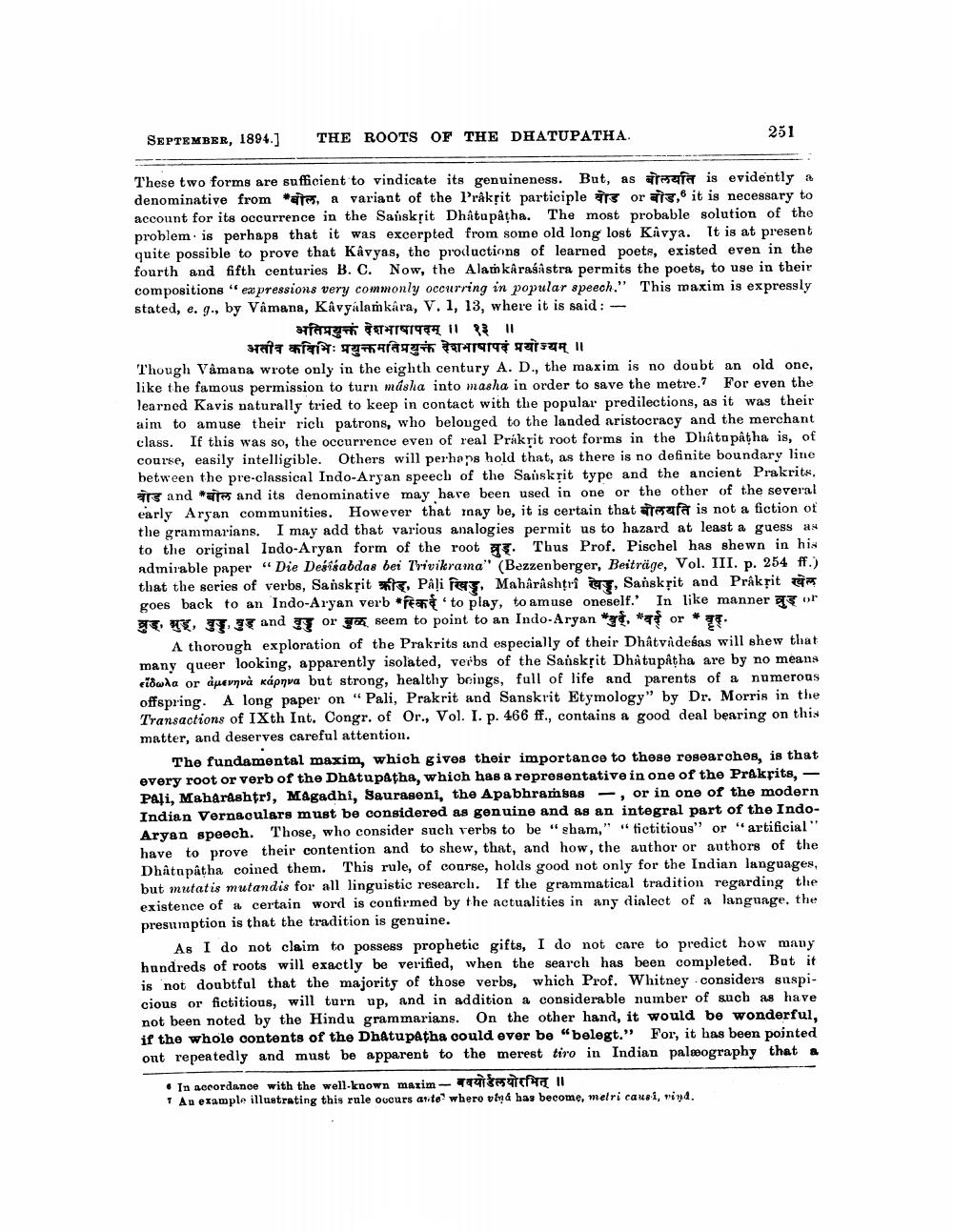________________
SEPTEMBER, 1894.]
THE ROOTS OF THE DHATUPATHA
251
These two forms are sufficient to vindicate its genuineness. But, as armara is evidently a denominative from Wats, a variant of the Prakrit participle irs or a3,6 it is necessary to account for its occurrence in the Sanskrit Dhâtapatha. The most probable solution of the problem is perhaps that it was excerpted from some old long lost Kavya. It is at present quite possible to prove that Kâvyas, the productions of learned poets, existed even in the fourth and fifth centuries B. C. Now, the Alam kâraśastra permits the poets, to use in their compositione "expressions very commonly occurring in popular speech." This maxim is expressly stated, e. g., by Vâmana, Kavyalamkara, V.1, 13, where it is said:
farge 1919 11 11
अतीव कविभिः प्रयुक्तमतिप्रयुक्त देशभाषापदं प्रयोज्यम् ॥ Though Våmana wrote only in the eighth century A. D., the maxim is no doubt an old one, like the famous permission to turn másha into masha in order to save the metre.7 For even the learned Kavis naturally tried to keep in contact with the popular predilections, as it was their aim to amuse their rich patrons, who belouged to the landed aristocracy and the merchant class. If this was so, the occurrence even of real Prakrit root forms in the Dhâta patha is, of course, easily intelligible. Others will perhaps hold that, as there is no definite boundary line between the pre-classical Indo-Aryan speech of the Sanskrit type and the ancient Prakrits, irs and areas and its denominative may have been used in one or the other of the several early Aryan communities. However that may be, it is certain that area is not a fiction of the grammarians. I may add that various analogies permit us to hazard at least a guess as to the original Indo-Aryan form of the root . Thus Prof. Pischel has shewn in his admirable paper “Die Desisabdas bei Trivikrama" (Bezzenberger, Beiträge, Vol. III. p. 254 ff.) that the series of verbs, Sanskļit *, Pâli rez, Maharashtri , Sanskrit and Prakṣit en goes back to an Indo-Aryan verb rei 'to play, to amuse oneself.' In like manner ago वड़ मुड़, बुद्ध, and or or मुळ seem to point to an Indo-Aryan *युर्व, “वई or * वृद्ध.
A thorough exploration of the Prakrits and especially of their Dhâtvideśas will shew that many queer looking, apparently isolated, verbs of the Sanskrit Dhậtupåtha are by no means ciðwia or åpevná kápnva but strong, healthy beings, full of life and parents of a numeroas offspring. A long paper on "Pali, Prakrit and Sanskrit Etymology" by Dr. Morris in the Transactions of IXth Int. Congr. of Or., Vol. I. p. 466 ff., contains a good deal bearing on this matter, and deserves careful attention.
The fundamental maxim, which gives their importance to these researches, is that every root or verb of the Dhatupatha, which has a representative in one of the Prakrits, - PAļi, Maharashtri, M&gadhi, Sauraseni, the Apabhramsas -, or in one of the modern Indian Vernaculars must be considered as genuine and as an integral part of the IndoAryan spooch. Those, who consider such verbs to be "gham," "fictitious" or "artificial have to prove their contention and to shew, that, and how, the author or authors of the Dhâtapâtha coined them. This rule, of course, holds good not only for the Indian languages, but mutatis mutandis for all linguistic research. If the grammatical tradition regarding the existence of a certain word is confirmed by the actualities in any dialect of a language, the presumption is that the tradition is genuine.
As I do not claim to possess prophetic gifts, I do not care to predict how many hundreds of roots will exactly be verified, when the search has been completed. But it is not doubtful that the majority of those verbs, which Prof. Whitney considers suspicious or fictitious, will turn up, and in addition a considerable number of such as have not been noted by the Hindu grammarians. On the other hand, it would be wonderful, if the whole contents of the Dhatupatha could ever be "belegt." For, it has been pointed ont repeatedly and must be apparent to the merest tiro in Indian palæography that a
• In accordance with the well-known marim-774130 II 1 An example illustrating this rule occurs ante where uma has become, melri cauri, vind.




